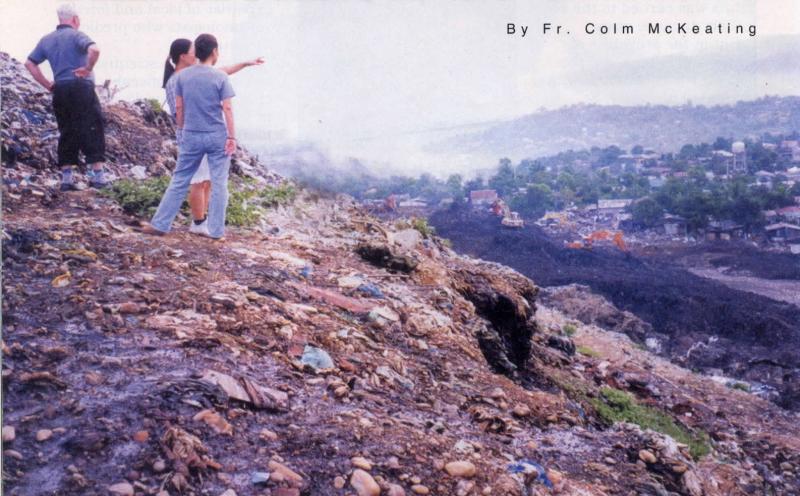The Horror Of Payatas
By: Fr Colm McKeating
The author, from Belfast, Northern Ireland, is Regional Director of the
Columbans in the Philippines.

The name Payatas evokes a horrible image: the 22-hectare, 22-to-45-meter-tall open dumpsite used to dispose of the daily garbage of Metro Manila. Located in a low-lying part of Quezon City, it was chosen about 20 years ago as a relocation area for the notorious ‘Smokey Mountain’ in Tondo, the similar dump and embarrassing eyesore close to the center of Manila. It was hoped that being less visible on the rim of the urban sprawl, it might lessen the impact of social squalor and perhaps become forgotten.
But over time, this mountain of garbage became home to about 80,000 people. Many of these, with no other options for survival, scavenge the waste for recyclables such as cans, plastic and newspapers to earn a few pesos a day. Disease and short life spans among these families are commonplace in the makeshift community ironically dubbed Lupang Pangako (the Promised Land).
An avalanche of garbage
On the fateful morning of 10 July 2000 an avalanche of rubbish buried the shanties where these people lived. More than 300 were killed. Payatas, the unwanted face of poverty, also became a symbol of devastation and death.
It was a disaster waiting to happen. Nature seemed to have colluded with human indifference and neglect. Ten days of torrential rains had brought floods to many parts of the city. All the attention was paid to relieving the plight of those in the affected areas.
Looming disaster
No one, however, had noticed what was happening to Payatas. The monsoon rains had loosened the packed garbage, and the dump’s massive base had become a seething quagmire. The inhabitants of hundreds of shanties huddled around the foot of the mountain of refuse remained unaware of the danger.
Ironically, conditions seemed to be improving when on the morning of 10 July the rains ceased and bright sunshine appeared. That’s when a rumble followed by two explosions could be heard. The mountain of garbage split in two, and the vast compost heap, a time bomb of methane gas, exploded. A massive landslide devastated the surrounding area, burying it in garbage and mud.
Aftermath
A few days after the tragedy, I visited with Fr Michael Martin and Won-Joung, a Korean Columban lay missionary. Our guide was Columba Chang, another Korean Columban lay missionary. Columba was no stranger to the people of Payatas: she had been living and working there for four years. She introduced us to friends and relatives of the dead. We met one 19-year-old man still numbed by the loss of his wife and ten-month-old son. We heard many other heart-rending stories, including one about a German couple who came to offer scholarships to the poor and lost their lives in the disaster. Their bodies had just been recovered that morning.
During our visit, our rescue services were still working to recover other bodies. Alongside, a wasteland stretched eerily untouched by the mechanical shovels used for pushing back the avalanche. Entire families and their makeshift homes lay buried beneath its six-meter-deep carpet of mud and slime.
Survivors deserve better
As I look back, there would be some cold comfort if it meant a lesson had been learned and something like this would never happen again. But there is no such assurance. Waste management for vast populations like Manila’s millions is one of the pressing problems created by rapid urbanization. Such disasters are not unique to the Philippines; two weeks after Payatas, a similar tragedy occurred in Mumbai, India. The frequency of these so-called natural disasters and the seemingly callous disregard by the powerful and wealthy towards these inhumane living conditions of the poorest do not inspire confidence that long-term solutions will be found.
Perhaps those who live and work around the dump will be relocated elsewhere. Maybe, as happened last time, the cycle will simply begin again in another inhuman environment. The people of Payatas, like us, have just one chance to live a life that is human. In a world where, for a minority, the problem is what to do with excess wealth, the survivors of Payatas deserve a better opportunity.
Salamat sa Columban Mission
